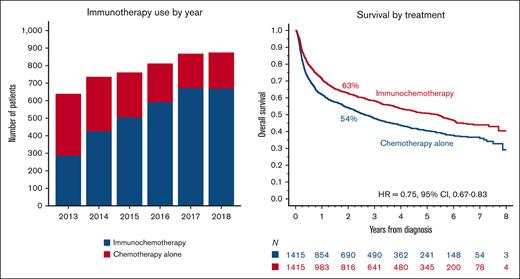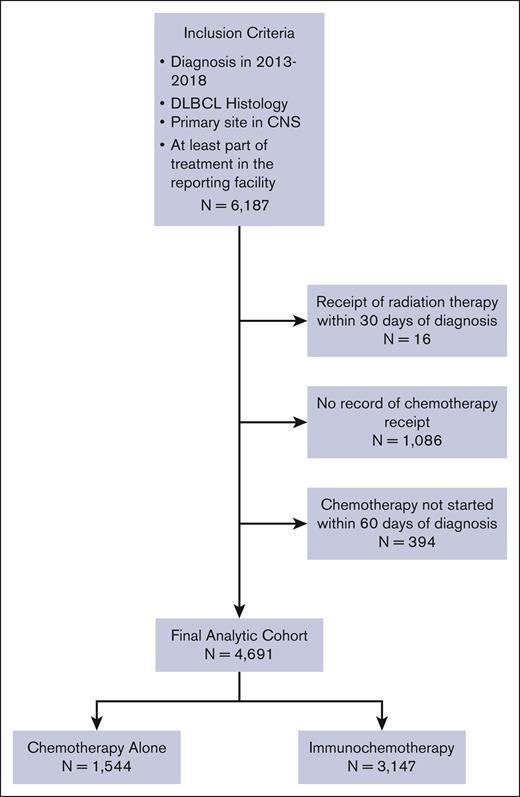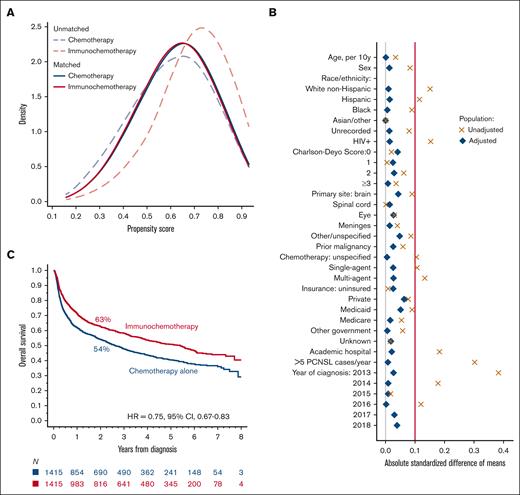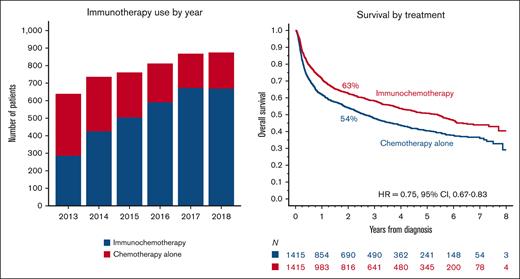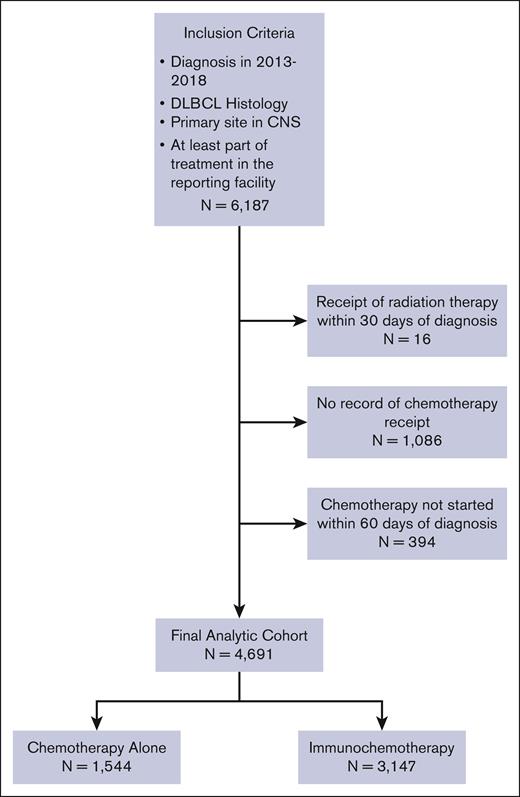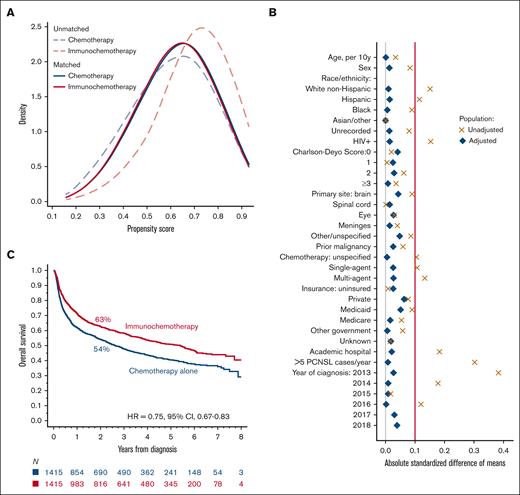Key Points
In a matched analysis, immunotherapy use was associated with improved OS in PCNSL (HR, 0.75; 95% CI, 0.67-0.83).
Reduced immunotherapy use was associated with male sex, Black race, HIV+ status, low treatment volume site, and earlier year of diagnosis.
Abstract
Debate remains over the role of rituximab, a large molecule with reduced central nervous system (CNS) penetration, in therapy for primary CNS lymphoma (PCNSL). Since 2013, the National Cancer Database has distinguished between chemotherapy and immunotherapy for frontline treatment. In this setting, rituximab would be the only standard frontline immunotherapy. We examined factors associated with the receipt of immunotherapy using a multivariate regression model for relative risk, with a random intercept to account for the hospital-specific treatment selection process. Patients were matched using a 1:1 propensity score to limit possible confounders, and overall survival (OS) was compared in the matched cohort. We identified 4691 patients with PCNSL diagnosed between 2013 and 2018. The use of immunotherapy has increased from 45% in 2013 to 76% in 2018. Immunotherapy use was associated with sociodemographic variables and local (hospital level) preference rather than clinical factors. The main factors associated with reduced use of immunotherapy included male sex, Black race or Hispanic ethnicity (compared with White non-Hispanic), HIV+ status, treatment in a lower-volume hospital, and earlier year of diagnosis. We matched 2830 patients for the survival analysis. Receipt of immunotherapy was associated with a significantly better OS (hazard ratio [HR], 0.75; 95% confidence interval [CI], 0.67-0.83). There was heterogeneity according to age, because the advantage of immunotherapy was more pronounced for patients aged ≤75 years (HR, 0.71; 95% CI, 0.63-0.80) than for those older than 75 years (HR, 0.87; 95% CI, 0.70-1.08). Overall, our findings support the current trend toward rituximab use, although a nuanced approach should be adopted when treating older patients.
Introduction
The treatment of primary central nervous system lymphoma (PCNSL) poses a unique challenge compared with systemic lymphomas because of the limited penetration of many therapeutic agents, including monoclonal antibodies, into the CNS compartment. PCNSL is currently classified by the World Health Organization as a subtype of primary large B-cell lymphoma of immunologically privileged sites and is associated with immunosuppression.1 Since the 1990s, immunosuppression has increasingly been attributed to immune senescence in older patients; however, before effective antiviral therapy, many cases have been associated with HIV infections.1,2 PCNSL is uncommon, with a prevalence of fewer than 10 cases per 1 million people annually, although its incidence is increasing among immunocompetent older adults.2-4 Compared with systemic diffuse large B-cell lymphoma (DLBCL), standard chemotherapies, such as rituximab, cyclophosphamide, doxorubicin, vincristine, and prednisone (R-CHOP) fail to adequately penetrate the CNS, and outcomes with such therapies have been dismal. The use of high-dose methotrexate (HD-MTX) combined with consolidative radiation was initiated in the early 1990s. This led to significantly improved outcomes over the prior standard of whole brain radiation therapy alone, which had high response rates but a relatively short duration of response.5,6
In systemic B-cell lymphomas, rituximab, a CD20-directed monoclonal antibody, has markedly improved outcomes over standard CHOP and has, thus, been part of standard therapies for most B-cell lymphomas for nearly 20 years.7 Although the addition of rituximab to HD-MTX-based treatment has been investigated in PCNSL, randomized trials have demonstrated variable results.8-11 A 2019 meta-analysis investigated the benefits and disadvantages of rituximab in the management of immunocompetent patients with PCNSL.11 The analysis suggested that rituximab may improve progression-free survival, with 137 fewer progressions or deaths in the 1000 treated patients after 2 years (hazard ratio [HR] 0.65, 95% confidence interval [CI] 0.45-0.95); however, it revealed no overall survival (OS) benefit.11 Despite no clear benefits, rituximab has been used in several pivotal clinical trials for PCNSL over the last 20 years and has become a generally accepted addition to HD-MTX-based regimens.9,12,13
Prior analysis of the National Cancer Database (NCDB) has provided insights into the management of PCNSL in the United States. An analysis of recorded cases from 2004 to 2013 demonstrated the benefit of multiagent over single-agent chemotherapy in PCNSL.14 Chemotherapy use, either single-agent or multiagent, increased from 65.6% to 78.8%during this time frame. There was a marked increase in the use of multiagent chemotherapy, as opposed to single-agent chemotherapy, after 2009, likely reflecting the results of several pivotal trials.15-17 Improved survival was noted with the use of multiagent chemotherapy, although the authors noted significant disparities in sociodemographic factors associated with the receipt of multiagent chemotherapy.14 NCDB began recording immunotherapy as a separate treatment variable in 2013. Because rituximab has become increasingly used in clinical trial protocols for PCNSL, we sought to address the factors associated with its use and any associated changes in the outcomes.
Methods
We used the NCDB Participant Use File to assess the patterns of immunotherapy used in PCNSL and described the outcome differences associated with its receipt. This study was exempted from human subject protection because of its reliance on deidentified data. The NCDB is a hospital-based oncology outcome registry that encompasses >1500 US cancer programs with >34 million cancer records as of 2016.18,19 It is a joint project of the Commission on Cancer of the American College of Surgeons and the American Cancer Society and captures ∼70% of all newly diagnosed cancer cases in the United States, including >80% of lymphomas. The registry includes disease-related data, including demographics, HIV status (for lymphomas only), cancer histology, stage of disease, and presence of B symptoms. Treatment data were recorded for the initial management strategy, including the use of surgery, radiation therapy, chemotherapy, and immunotherapy. Beginning in 2013, the NCDB started to separately record the use of immunotherapy for the treatment of non-Hodgkin lymphoma, whereas other agents typically used for the treatment of PCNSL (methotrexate, cytarabine, procarbazine, etc) were recorded as single-agent or multiagent chemotherapy. This change allowed for the study of rituximab as an addition to chemotherapy, with a high degree of confidence. The NCDB registries do not record the names of specific chemotherapy or immunotherapy agents, doses, duration of treatment, or the number of courses of chemotherapy. The response to therapy, its toxicities, or subsequent clinical course (including progression or relapse of cancer, or further lines of therapy) were also unrecorded, and OS was the only outcome available for analysis.
Using NCDB data from 2013 to 2018, we identified patients with a diagnosis of DLBCL (using histology codes from the International Classification of Diseases for Oncology, third edition) at a primary site consistent with that of PCNSL, including the brain, spinal cord, meninges, and eyes.1 We excluded patients without a histologic confirmation of the diagnosis, those who were reported by a facility that did not provide the initial course of treatment, those who did not receive chemotherapy within 60 days of diagnosis, and those who were initially treated with radiation therapy within 30 days of diagnosis (Figure 1). Patients were grouped according to the type of first-line regimen as receiving chemotherapy alone or immunochemotherapy (defined as immunotherapy starting no later than 30 days after the first chemotherapy), and this treatment assignment constituted the main exposure of interest for the analysis. HIV status was recorded as positive or negative or was unrecorded (a classification used in prior registry-based studies).3,20,21 We did not consider the stage variable because there was no uniform or clinically relevant staging system for PCNSL. The NCDB provides the count of patients’ comorbidities using the Charlson comorbidity index.22 Reporting hospitals were classified as academic/research- or community-based (including comprehensive community centers) centers according to the internal NCDB designation, which uses facility volume and the scope of available oncology services. We additionally calculated facility volume for PCNSL cases as the average number of reported PCNSL cases per year of data and dichotomized the volume using the optimal area-under-curve after checking possible cutoffs. OS was the primary end point of the study.
Baseline patient characteristics were tabulated using frequencies and percentages for categorical variables, and medians with interquartile range for continuous variables. We studied factors associated with the receipt of immunochemotherapy (rather than chemotherapy alone) in a multivariable generalized linear model for relative risk,with a random intercept to account for the hospital-specific treatment selection process.23,24 To examine the OS among patients treated with chemotherapy alone or with immunochemotherapy while accounting for potential confounding factors, we applied a propensity score-matching method using a previously described multistep process.23,25,26 Firstly, the propensity to receive immunochemotherapy (rather than chemotherapy alone) was calculated for each patient using a multivariable logistic model that included all recorded confounders: age, sex, race/ethnicity, comorbidity index, HIV status, primary anatomical site of lymphoma, history of prior malignancy, type of chemotherapy received (single-agent or multiagent), type of health insurance, type of cancer program reporting (academic or community-based), average yearly number of PCNSL cases treated by the program, and year of diagnosis. According to the principles of causal analysis, no factors ascertained after the initiation of treatment (eg, receipt of stem cell transplantation or subsequent radiation therapy) were included in the propensity score model. Patients treated with immunochemotherapy or chemotherapy were matched using the calculated score in a 1:1 ratio. We confirmed an adequate balance of all confounders in the matched cohort by comparing the standardized differences in the means for each variable. We then plotted the OS curves and calculated the corresponding HR using a univariate proportional hazard model, accounting for the matched nature of the cohort. All estimates are provided with 95% CIs. Analyses were conducted using Stata/SE17.0 (StataCorp LP, College Station, TX).
Results
Case identification
We identified 4691 patients with PCNSL diagnosed between 2013 and 2018 who met the study inclusion criteria (Table 1), with a median age of 66 years. Those who did not receive immunotherapy were slightly more likely to be male (54% vs 46%). Most patients were White non-Hispanic (WNH), and this percentage was higher in the immunochemotherapy group than in the chemotherapy group (80.5% vs 74.2%). Most participants had private insurance, followed by Medicaid and Medicare. More than half of the patients were treated in academic medical centers, but most were treated in centers with fewer than 5 PCNSL cases per year.
Factors associated with the use of immunotherapy
Concurrent immunochemotherapy (rather than chemotherapy alone) was administered to 3147 (67%) patients, and this proportion increased from 45% in 2013 to 76% in 2018 (Figure 2A). We did not observe a significant association between immunochemotherapy use and patient age (Figure 2B). The use of immunochemotherapy was less frequent among patients who tested as HIV+ and lower for those who were Black or Hispanic than for those who were WNH, regardless of HIV status (Figure 2C). Furthermore, immunochemotherapy was more frequently applied in academic/research hospitals and facilities with a higher average volume of PCNSL cases observed every year than in community-based centers (Figure 2D).
Factors associated with the use of immunochemotherapy rather than chemotherapy alone for PCNSL. (A) Number of patients receiving either treatment options each year. (B) Association between age and the probability of receiving immunotherapy (fitted line from a fractional polynomial fit; markers are sized according to the number of patients in each age group). (C) Association between HIV status, race/ethnicity, and receipt of immunochemotherapy; the interaction test between HIV and race/ethnicity was not statistically significant (P = .31); note that data for patients tested positive for HIV of Asian or other race/ethnicity are suppressed per the NCDB policy (<11 patients). (D) Association between facility volume (expressed as the average number of PCNSL cases per year reported to NCDB) and frequency of immunochemotherapy use (fitted line from a fractional polynomial fit; markers are sized according to the number of patients in each age group).
Factors associated with the use of immunochemotherapy rather than chemotherapy alone for PCNSL. (A) Number of patients receiving either treatment options each year. (B) Association between age and the probability of receiving immunotherapy (fitted line from a fractional polynomial fit; markers are sized according to the number of patients in each age group). (C) Association between HIV status, race/ethnicity, and receipt of immunochemotherapy; the interaction test between HIV and race/ethnicity was not statistically significant (P = .31); note that data for patients tested positive for HIV of Asian or other race/ethnicity are suppressed per the NCDB policy (<11 patients). (D) Association between facility volume (expressed as the average number of PCNSL cases per year reported to NCDB) and frequency of immunochemotherapy use (fitted line from a fractional polynomial fit; markers are sized according to the number of patients in each age group).
In a multivariable model (Table 2), the main factors associated with the reduced use of immunotherapy included male sex, Black race or Hispanic ethnicity, WNH, HIV+ status, treatment in a lower-volume hospital, and year of diagnosis. There were no significant differences in age, number of comorbidities, type of chemotherapy (single vs multiagent), anatomical location of the PCNSL, or type of hospital (academic vs community). The statistically significant difference based on the insurance type was driven by a small group with other government insurance, which mainly included military service benefits. We also observed no statistically significant interactions between race/ethnicity and either sex or HIV status (data not shown). We found evidence for a strong preference for the use/non-use of immunotherapy in each hospital (P < .0001 for a likelihood ratio test against a model without the random intercept).
Survival analysis
In the entire cohort, the median follow-up was 4.1 years (95% CI, 4.0-4.2), and the median OS was 4.2 years (95% CI, 3.9-4.6). The OS at 3 years was 55.3% (95% CI, 53.8-56.8). Comparing treatment, the 3-year OS was 47.4% for chemotherapy alone (95% CI, 44.9-50.0) and 59.2% for chemoimmunotherapy (95% CI, 57.4-61.0).
We matched 2830 patients in a 1:1 ratio according to the receipt of immunochemotherapy or chemotherapy alone, successfully minimizing intergroup differences for all observed confounders (Figure 3A,B). In the matched cohort, the median OS for recipients of immunochemotherapy was 5.4 years (95% CI, 4.2-5.9) compared with 2.6 years (95% CI, 2.2-3.1) for recipients of chemotherapy alone; the 2-year OS estimates were, respectively, 62.6% (95% CI, 60.0-65.1) and 54.2% (95% CI, 51.2-56.8). Receipt of immunotherapy was associated with a significantly better OS (HR, 0.75; 95% CI, 0.67-0.83; Figure 3C). We observed no heterogeneity based on propensity score decile, HIV status, or type of cytotoxic chemotherapy (single or multiagent; data not shown). We did, however, observe some heterogeneity according to age, because the advantage of immunotherapy was only significant for patients aged ≤75 years (HR, 0.71; 95% CI, 0.63-0.80) and not for those older than 75 years (HR, 0.87; 95% CI, 0.70-1.08).
Outcome analysis in the propensity score–matched cohort. (A) Distribution of the propensity score before and after matching. (B) Standardized differences in the means of confounding variables included in the study before and after matching (standardized difference <0.1, typically considered to indicate adequate mitigation of bias). (C) OS in the matched cohort according to the receipt of first-line immunochemotherapy or chemotherapy alone.
Outcome analysis in the propensity score–matched cohort. (A) Distribution of the propensity score before and after matching. (B) Standardized differences in the means of confounding variables included in the study before and after matching (standardized difference <0.1, typically considered to indicate adequate mitigation of bias). (C) OS in the matched cohort according to the receipt of first-line immunochemotherapy or chemotherapy alone.
In addition, we conducted a confirmatory analysis using an alternative propensity score model application, with an inverse probability of treatment weight (N = 4691). The resulting overall HR was consistent (HR, 0.77; 95% CI, 0.70-0.84), and we observed similar heterogeneity by age group: for patients aged ≤75 years, the HR was 0.76 (95% CI, 0.67-0.87), whereas for those aged >75 years, it was 0.91 (95% CI, 0.72-1.15).
Discussion
Through this nationwide data set, we described treatment patterns in PCNSL and outcome differences that could help lead to more standardized treatment practices regarding the use of immunochemotherapy in PCNSL. Several factors were associated with their use. Black and Hispanic race/ethnicity and HIV positivity were factors associated with a reduced likelihood of these subsets of patients receiving immunotherapy. Academic and high-volume centers were more likely to provide immunotherapy than community-based centers. OS estimates improved for recipients of immunochemotherapy compared with estimates for recipients of chemotherapy alone, even after accounting for other baseline characteristics.
Unlike many aggressive lymphomas, the lack of large and definitive clinical trials for PCNSL has led to variability in practice. The only treatment paradigm with consensus in PCNSL is that for eligible patients, HD-MTX should provide a backbone for induction therapy. The use of additional agents is generally accepted to improve outcomes. One of the first studies to add additional agents to an HD-MTX backbone, the International Extranodal Lymphoma Study Group 20 (IELSG 20) study, investigated the benefits of HD-MTX alone vs combination therapy with cytarabine. The combination arm attained superior results, with 46% in the combination arm achieving a complete response compared with 18% with single-agent HD-MTX at 3.5 g/m2.17 Since then, combination therapy has generally been accepted as superior to single-agent HD-MTX in terms of overall response rates and survival, although only few phase 3 studies exist for direct comparison.6 As such, multiagent chemotherapy has supporting evidence for its use and has become the standard of care for eligible patients.6 A prior study using the NCDB data reported an association between the use of multiagent vs single-agent chemotherapy with a 3-year OS for multiagent chemotherapy of 51.8% vs 37.7% for single-agent chemotherapy.14
The chemotherapy agents used in PCNSL (HD-MTX, cytarabine, procarbazine, and thiotepa) have a well-documented ability to penetrate the CNS, whereas rituximab does not. Rituximab is a large monoclonal antibody; therefore, its large size leads to questions regarding its ability to penetrate the blood-brain barrier (BBB), an established problem for CHOP.27,28 In systemic DLBCL, rituximab increases event-free survival by 15% or 20% as well as the OS, when added to CHOP.7,29 Postinfusion pharmacokinetic analysis from a study evaluating the safety of adding rituximab to HD-MTX noted that the cerebrospinal fluid levels of rituximab ranged from 3.3% of the corresponding median serum levels at 1 hour after infusion to 4.4% at 18 hours after infusion and 4.1% at 24 hours after infusion.12 CNS penetration may increase earlier in the course of the disease, when the mass effect and inflammation can lead to disruption of the BBB.30,31 Targeting the BBB may allow for the efficacy of traditional lymphoma therapies. In a phase 2 trial, NGR-hTNF increased vascular permeability by targeting CD13 and led to a 75% overall response rate for R-CHOP in PCNSL.32
Single-arm and retrospective investigations have suggested improved progression-free survival with rituximab.28,33,34 A retrospective study of 120 patients with PCNSL, 18 of whom received rituximab, found that both cytarabine and rituximab in the treatment regimen predicted improved survival in a univariate analysis.35 Two large prospective and randomized studies investigated the effects of rituximab therapy in patients with PCNSL. The IELSG 32 study featured 3 randomized treatment arms.9 Arm A consisted of HD-MTX and cytarabine, arm B included rituximab, and arm C included rituximab and thiotepa.9 At a median follow-up of 88 months, the 7-year OS for arm A was 21%, arm B was 37%, and arm C was 56%.10 It was postulated in the study that the significant improvement in arm B compared with arm A was secondary to the addition of rituximab. HOVON 105/ALLG NHL 24 was a randomized phase 3 study of HD-MTX-based chemotherapy with or without rituximab.8 Patients with a response at the end of induction therapy then received cytarabine and patients aged ≤60 years also received low-dose whole brain radiotherapy. Neither event-free (HR, 1.0; 95% CI, 0.70-1.43) nor progression-free survival (HR, 0.77; 95% CI, 0.52-1.13) showed a significant difference between the study arms. Thus, this study did not support the addition of rituximab to HD-MTX, carmustine, teniposide, or prednisone chemotherapy for PCNSL.8 Interestingly, a post hoc subgroup analysis of this trial found a significant interaction between age and assignment to the rituximab-containing arm (P = .015). The observed HR for rituximab administration in the subgroup of younger patients ≤60 years old suggested a benefit (HR, 0.48; 95% CI, 0.26-0.88), whereas no improvement was observed in the older subgroup (HR, 1.05; 95% CI, 0.64-1.72). The OS difference was not statistically significant, but it appears consistent with our observational data, suggesting that the survival benefit of rituximab in younger patients may be real. A meta-analysis of HOVON 105/ALLG NHL 24 and IELSG 32 further evaluated the role of rituximab in PCNSL.11 The analysis included survival, quality of life, and treatment-related toxicity. Rituximab did not improve OS (HR, 0.76; 95% CI, 0.52-1.12), yet might have improved progression-free survival (HR, 0.65; 95% CI, 0.45-0.95).11 There was also no appreciable increase in grades 3 and 4 toxicity with rituximab (relative risk, 0.53; 95% CI, 0.20-1.37). The differential outcomes of rituximab-based immunochemotherapy for younger and older patients may be hypothetically explained by several phenomena. If rituximab increases the probability of complete response in the context of multiagent chemotherapy for PCNSL (as in IELSG-32, although the depth of response could not be ascertained from our NCDB data set), its use may allow for a more successful downstream management, including the use of consolidative autologous stem cell transplantation or radiation therapy, which, in turn, may affect long-term survival. Alternatively, older patients with PCNSL have inferior outcomes, largely determined by their tolerance to multiagent chemotherapy and lack of effective consolidative options.36-38 Some clinicians opt for single-agent HD-MTX, with or without rituximab, in patients who are less fit or older.36-38 In our analysis, the HR for the use of immunotherapy remained <1.0 for patients older than 75 years, yet we did not observe a statistically significant benefit. Without more data on geriatric assessments that may better guide the role of rituximab in older patients, its use may require a nuanced approach, with any individualized benefit related to fitness for more intensive therapy. In a general sense, its use in the older population cannot be guided by this analysis.
The NCDB only reports county-level indicators of poverty, educational attainment, or population density; however, the disparities in our findings regarding the variable administration of immunotherapy based on race/ethnicity raise concerns over equity in therapy. Although age was not associated with the receipt of immunotherapy, both facility characteristics and race/ethnicity were associated with immunotherapy administration. Academic centers and those treating more PCNSLs were more likely to administer immunotherapy. Physicians treating PCNSL infrequently may have less comfort with multiagent rituximab-containing regimens and may also face challenges related to differential reimbursement for inpatient (HD-MTX) and outpatient (rituximab) components of the regimen in the United States. Access to consolidative autologous stem cell transplantation may be reduced in lower-volume centers as well, reflecting differences in survival outcomes, which cannot be analyzed through variables included in the NCDB.
Although our study relied on the experience and outcomes of the vast majority of patients with PCNSL managed in the United States between 2013 and 2018, it has significant limitations related to the content of the NCDB data and its retrospective design. OS was the only outcome available for analysis, although rates of response, treatment-related toxicities, and progression-free survival would be important for a comprehensive assessment of combination immunochemotherapy as a therapeutic option. The description of systemic therapy in NCDB is limited to the classification as single or multiagent chemotherapy and, separately, immunotherapy. Therefore, our analysis could not balance multiple specific regimens used in clinical practice (methotrexate with cytarabine and/or thiotepa, methotrexate with temozolomide, or methotrexate with procarbazine and vincristine) between the compared arms.9,13,37 The only immunotherapy agent commonly used as part of the first-line treatment for PCNSL in current practice is rituximab, justifying our analytic assumption. Other agents, including ibrutinib, lenalidomide, or monoclonal antibodies targeting immune checkpoint receptors are under exploration for PCNSL, so they would not have been incorporated in the first-line therapy besides very small clinical trials.39-42 Although we were able to identify patient with HIV positivity in the data and did not observe significant heterogeneity in the association between immunotherapy use and OS according to HIV status, we could not ascertain the depth of immunosuppression (including CD4+ T-cell count and the use of retroviral agents), which might have altered the risk–benefit ratio of rituximab in this context. Moreover, we could not include performance status or specific organ function parameters (eg, renal disease) as confounders, although they may not majorly affect the decision to administer monoclonal antibody therapy to a patient able to receive HD-MTX.43 The NCDB does not contain information on consolidative modalities in PCNSL, such as radiation therapy, high-dose chemotherapy with stem cell rescue, or maintenance therapy. Fewer older patients can tolerate myeloablative chemotherapy with stem cell rescue. Patients in less-experienced settings could possibly receive less intensive treatment, which may impair outcomes, independent of rituximab administration. However, despite these limitations in the available data on consolidation treatments, the effect of rituximab likely cannot be explained simply by its association with the intensity of initial regimens or the subsequent choice of consolidation modality. In this analysis, the separation of the OS curves was done early (within 1 year of diagnosis); because relapse after HD-MTX therapy occurs at a median of 10 or 18 months,5 the aforementioned limitations are less likely to have an impact on the effect of rituximab as part of the initial therapy (Figure 3C). Finally, with the well-defined risk of increased complications from COVID-19 associated with CD20-directed therapies, the time frame of our analysis might have not captured the associated considerations of risks and benefit of the use of rituximab in PCNSL.44
In conclusion, our findings demonstrate that most patients with PCNSL diagnosed in the United States now receive first-line immunotherapy (presumably rituximab) despite the lack of strong evidence of a survival benefit from prior studies. Additional randomized trials addressing the potential advantages of rituximab added to specific regimens are unlikely to be pursued further, because clinical trials prioritize novel agents. In this context, using causal inference methods and a large-scale data set, we provide observational, real-world evidence of the potential benefit of combination immunochemotherapy, particularly for younger patients with PCNSL. Further research should address the notable disparities in the application of immunotherapy according to patient- and hospital-related factors.
Acknowledgments
The data used in this study are derived from a deidentified NCDB file.
The American College of Surgeons and Commission on Cancer have not been verified and are not responsible for the analytic or statistical methodology used or the conclusions drawn from these data by the investigator.
Authorship
Contribution: T.A.O. and A.J.O. performed the analysis and drafted the manuscript, and P.M. and R.T. assisted with the manuscript preparation.
Conflict-of-interest disclosure: T.A.O. reports consulting fees and research funding from ONO Pharmaceuticals. A.J.O. is a scholar in Clinical Research of the Leukemia & Lymphoma Society; reports consulting fees from Schrodinger and Genmab; receives research funding from Genentech, Genmab, TG Therapeutics, Celldex Pharmaceuticals, and PrecisionBiotics Group; and receives grants from Acrotech Pharma, Adaptive Biotechnologies, outside the submitted work. The remaining authors declare no competing financial interests.
Correspondence: Thomas A. Ollila, Hematology/Oncology, Alpert Medical School of Brown University, Rhode Island Hospital, 593 Eddy St, Providence, RI 02903; e-mail: thomas_ollila@brown.edu.
References
Author notes
Presented in abstract form at the 64th annual meeting of the American Society of Hematology, New Orleans, LA, 10-13 December 2022.
Data are available on request from the corresponding author, Thomas A. Ollila (thomas_ollila@brown.edu).

